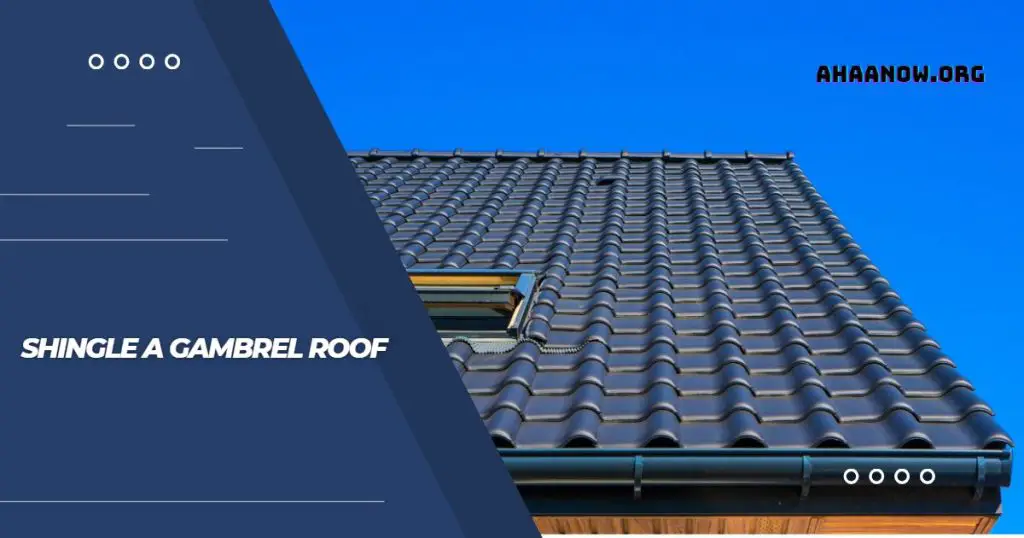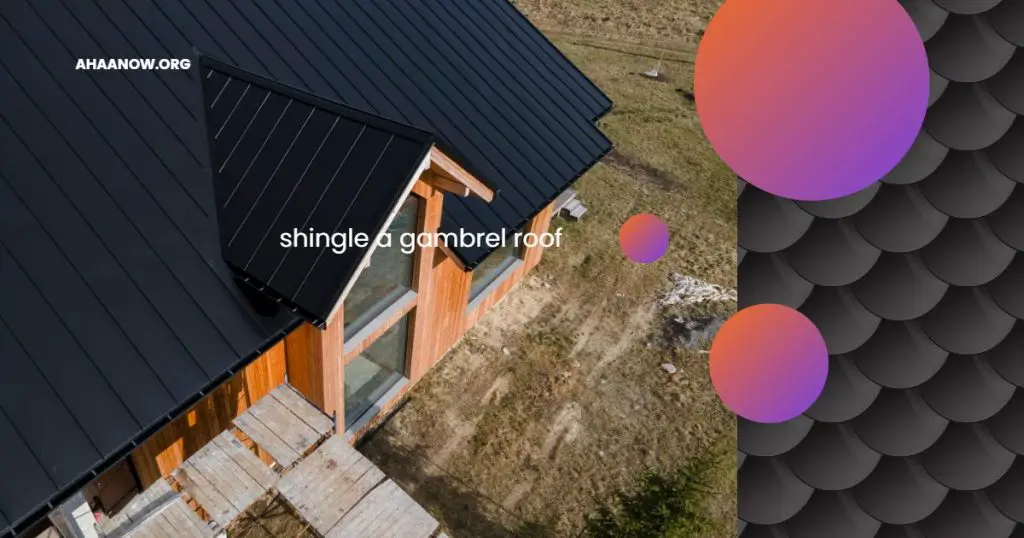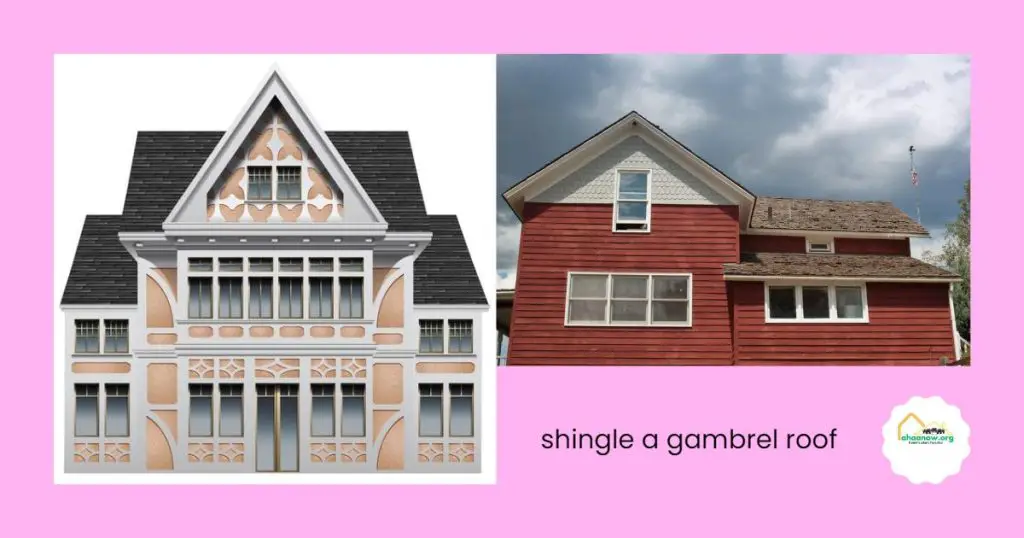As an Amazon Associate, I earn from qualifying purchases

Shingling a gambrel roof is a common roofing project that requires careful planning and execution. A gambrel roof has two distinct slopes on each side of the ridge, with the lower slope being steeper than the upper slope. The shingling process involves installing overlapping rows of shingles starting at the bottom edge of the roof and working upwards towards the ridge. In this article we know about How to shingle a gambrel roof.
Before you begin shingling, it is important to properly prepare the roof surface by removing any old shingles, repairing any damage to the roof deck, and installing appropriate underlayment.
Prepare the roof surface: -How to shingle a gambrel roof

Before you begin shingling, you should remove any old shingles, repair any damage to the roof deck, and install appropriate underlayment.
It is good to check the condition of the roof deck before shingling it. There could be holes, cracks or any other problems that will require you to repair the roof. The roof must be cleaned thoroughly and free of debris, especially if you are going to use tar paper for the underlayment. The roof must be completely dry before you begin installing the new shingles.
Before you begin, make sure that you measure the length of the eaves and the ridgeline. This will help you to plan your shingling pattern. Next, place the first row of shingles. Remember that the bottom edge of the shingles should extend beyond the outermost eave line. The next row of shingles should be placed over the first row, extending beyond the eave line. Continue in this manner until the roof is shingled.
The best time to shingle is early spring.
Understanding the Structure of a Gambrel Roof
Before you begin shingling, it’s important to understand the design of a gambrel roof. Its distinct shape provides more living space in the attic or the upper floor.
Key Features:
- Upper Slope: This part of the roof is not tremendously steep and easier to walk on.
- Lower Slope: This section is a lot steeper, akin to a Mansard roof, and provides the unique profile of the gambrel style.
Understanding this design will guide you in the application of shingles for both optimal coverage and aesthetic appeal.
Gather materials and tools: -How to shingle a gambrel roof
When you install shingles on a gambrel roof, you will need to use a ladder. Before you start shingling, you should check the weather forecast and prepare for rain. You should check the roof frequently and make sure that there is no water damage. When you begin shingling, you should use a utility knife to cut the shingles to the proper size.
Place each piece at the proper angle. Make sure that the edges of the pieces overlap the edges of the previous layer. After you are done, check to make sure that the edges of the shingles are perfectly straight. Next, use a chalk line to mark the ridge line. You should also make sure that the roof is completely dry before you install the shingles.
Once you have marked the line, you should remove all of the nails from the shingles. Then, you should nail each shingle at the correct height and width. Make sure that the first row of shingles extends beyond the outermost eave line. The second row should be placed over the first row, extending beyond the eave line.
Lay out the first row of shingles:
Shingle roofs can be expensive and tricky to build. They are used for barns, sheds, garages, and carports. Although they can be built from metal, wood is usually the material of choice. Usually, the gambrel method is used to build them. You can build this type of roof yourself if you know how. Before you begin building the roof, make sure that you have the materials available.
Once you have all the materials ready, you can start the process of building the roof. You will first need to build the roof frame. Use 2x10s or 2x12s for the rafters. For the ridge pole, use 2x10s or 2x12s as well. You should use two pieces of 2×10 or 2×12 to make each ridge pole. The ridges should be spaced 12 inches apart. You can cut these pieces to length before you start installing the shingles.
Shingle the roof:
First, lay out the pattern for the roof. Use a chalk line to determine the width of the roof.
Install subsequent rows of shingles:
Gambrel roofs have four sides. There are two roofs above the first and two above the second. These roofs are attached to each other in the middle by an arch called the ridgepole. The two roofs over the first side are called the front gable and the back gable. The two roofs over the second side are called the front gable and the back gable.
Shingling a gambrel roof is a complicated process. To simplify it, we’ll discuss how to shingle a gambrel roof. This is not a roof that you can purchase. It requires a fair amount of skill and experience. If you have the skill and time, this is a rewarding project. You can do this in many ways. You can buy the material and shingle the roof yourself, hire someone to do it for you, or have it done by a professional.
The material for this type of roof is known as sheathing. Sheathing consists of 2×10 or 2×12 lumber that is nailed together and covered with 1/16″ plywood. The plywood is nailed to the sheathing with 16d nails.
Cut shingles to fit: – How to shingle a gambrel roof
You should follow a few guidelines while putting up this roof. The first thing you should do is to cut the 2×10 sheathing to a length of 9′ and make sure that all the cuts are square. After that, you should put the plywood over the sheathing. Put one layer of plywood on top of the sheathing and then another layer on top of that. The last thing you should do is to nail the shingles over the plywood.
The next thing you should do is to cut some of the shingles to size. Use a utility knife to trim them to a thickness of 1/16″. This is an easy way to do this. Once you have the shingles ready, you can start putting them up. Make sure that you measure the height of the ceiling and the roof pitch and then calculate how many shingles you will need to finish the job. It is a good idea to use an angle gauge to check the pitch. Check the pitch with this tool.
Install ridge caps:

Before you start installing your roof, you must make sure that you have the necessary materials available. You should also decide where you are going to install the shingles and cut them to size. If you are using a gambrel roof, you should use 3-tab shingles. To make sure that you are doing the installation right, you should use an angle gauge to check the roof pitch.
Roofs with a lower pitch require fewer shingles than roofs with a higher pitch. When you are measuring the pitch, you should do this only on one side of the building. You should measure it both ways, and then average the two measurements. The roof pitch is measured as a percentage. If you want to get started, you should measure the roof pitch and then use that figure to figure out how many shingles you need to cover the roof.
To install the shingles, you should use a utility knife to cut them to size. Make sure that you measure the ceiling height and the roof pitch and then use these figures to calculate how many shingles you will need to finish the job.
Clean up:
If you are planning to install new siding, you should know the type of shingle you will need to install it. You can do this by using an angle gauge. The recommended range for the roof slope is 12% to 16%. The vertical wall of a structure serves as the base for measuring roof pitch. The inclination of the roof is known as the roof pitch. This angle is also referred to as the roof pitch. The roof pitch is usually expressed as a percentage.
For example, a roof with a 12% pitch has a roof pitch of 12%. A roof with a 15% pitch has a roof pitch of 15%. The roof pitch is the most important factor in determining how many shingles you need. If you want to learn more about how to shingle a gambrel roof, you can read more about the process on the internet. If you want to install new siding on a house, you should get the most appropriate kind.
You should buy the right siding for your home. The type of siding you use is important because it determines how well your house will look.
Attention!
Check all seals and ensure you haven’t missed any shingles, particularly on the roof’s edges. Look down from the ridge to ensure that the lines of shingles are straight and evenly spaced. If you find any gaps or misaligned shingles, rectify these issues promptly. Additionally, inspect the roof for any stray nails or debris, and clean these up to prevent injury or roofing damage. Proper cleanup after installation is as important as the installation-itself.
After your final inspection, consider taking pictures of your completed roof for future reference. This step is often overlooked but can be essential for insurance purposes or future repairs. It also serves as a visual confirmation of your project’s success, capturing the effort and attention to detail you’ve devoted. With your gambrel roof now appropriately shingled, you can enjoy the peace of mind knowing your home is well-protected, your labor was well spent, and your building has that timeless gambrel aesthetic.
Should you encounter any issues with your shingles after installation whether they stem from storm damage, wear and tear, or another cause it’s essential to tackle repairs swiftly to prevent further damage to your roof. Regular maintenance checks, including after extreme weather events, will help ensure that your gambrel roof remains in top condition. If you’re not confident in conducting these repairs yourself, consider hiring a professional roofer to assess and fix any damage.
Conclusion
In a conclusion of How to shingle a gambrel roof, Shingling a gambrel roof can be a challenging but rewarding project that requires careful planning and execution. By properly preparing the roof surface, gathering the necessary tools and materials, and following a step-by-step process, you can achieve a strong and watertight roof that will provide long-lasting protection for your home.
Remember to always prioritize safety when working on a roof, and don’t hesitate to seek the help of a professional roofer if you have any doubts or concerns about your ability to complete the project on your own.

Leave a Reply